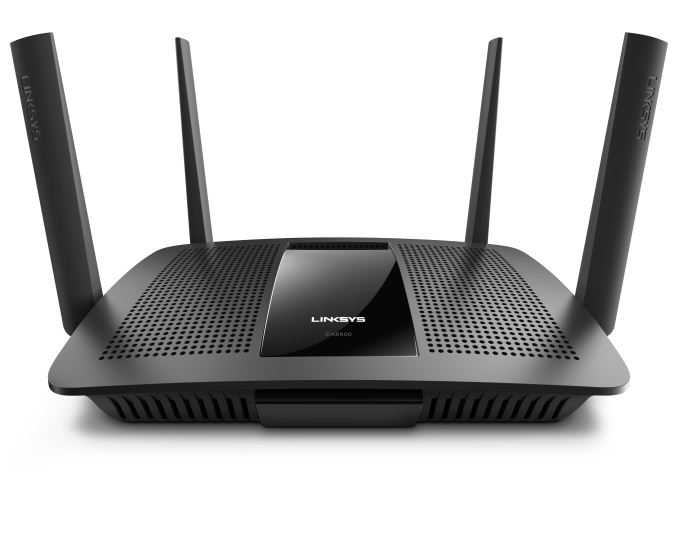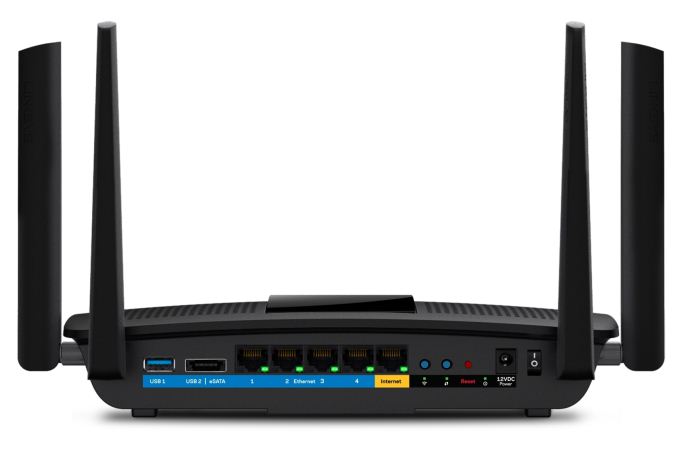Linksys EA8500 - First MU-MIMO Enabled 802.11ac Router Set to Ship
by Ganesh T S on May 7, 2015 7:00 AM EST- Posted in
- Networking
- Linksys
- 802.11ac
- Wi-Fi
- Qualcomm Atheros

Readers following our wireless networking coverage must be quite familiar with the developments in 802.11ac land. As a recap:
- The first 3-stream 802.11ac routers (based on the Broadcom BCM4706 chipset) started shipping in May 2012, with Buffalo Technologies and Netgear leading the way. There were marketed as AC1750 units (3x3 5 GHz providing up to 1300 Mbps and 3x3 2.4 GHz providing up to 450 Mbps). The street pricing of the AC1750 routers started to go down once Qualcomm started shipping their first-generation 802.11ac router platforms in products such as the TP-LINK Archer C7 in April 2013.
- In Q4 2013, a wave of AC1900 units started to hit the market. Netgear's Nighthawk R7000, a popular member in this series, still continues to sell well in the market. These units still used a 3x3 5 GHz radio for up to 1300 Mbps, but the 2.4 GHz had some proprietary Broadcom extensions (TurboQAM) to support up to 600 Mbps in an end-to-end Broadcom environment.
- In 2014, Quantenna began to bring their technology lead in the Wi-Fi space to the market with their Wave 2 4x4 802.11ac chipset. Despite being announced at CES 2014, the Asus RT-AC87U began to ship in July with the QSR1000 radio coupled with a Broadcom SoC. Netgear started to ship the same radio coupled with a Qualcomm IPQ8064 SoC in the Nighthawk X4 in September 2014. The QSR1000's Wave 2 feature set includes support for MU-MIMO, but neither of these routers shipped with MU-MIMO enabled in the firmware (citing lack of client support at that point of time). Given the 4x4 configuration, these routers were tagged as AC2350 / AC2400 units (600 Mbps in the 2.4 GHz band and 1733 Mbps in the 5 GHz band)
- In the midst of these Wave 2 product launches, Qualcomm announced plans for their Wave 2 802.11ac platforms (both routers and clients) in April 2014. Broadcom, being late to the Wave 2 party, decided to bring out the XStream platform with dual 5 GHz radios (six-stream configuration) also in April. They were able to get it quickly into the market too, with the Netgear Nighthawk X6 R8000 becoming available in June 2014.
- At CES 2015, we saw the first set of routers based on Qualcomm's QCA9880 4x4 Wave 2 802.11ac router platform getting announced. Vendors such as TP-LINK and TRENDnet were expecting their AC2600 class routers to ship towards the middle of the year.
Coming back to today's announcement regarding the EA8500, Linksys is becoming the first vendor to start shipping a QCA9980-based router. The important aspect here is that the router will ship with MU-MIMO enabled. Client devices with MU-MIMO enabled are also coming into the market just now (more on that in our detailed review). Hopefully, this announcement will spur both Netgear and Asus to enable MU-MIMO in the firmware for their Quantenna-based routers.
The salient features of the EA8500 router are listed below:
- 4x4 802.11ac with MU-MIMO and beamforming support
- QCA9980 radio + 1.4 GHz dual-core IPQ8064 SoC
- Simultaneous dual-band operation (5 GHz 802.11ac - 1733 Mbps, 5 GHz 802.11n - 600 Mbps, 2.4 GHz 802.11n - 800 Mbps)
- 1x USB 3.0, 1x USB 2.0 / eSATA
- 4x 1Gbps LAN, 1x 1Gbps WAN
- Adjustable antennas for optimal performance
One important point to note is that MU-MIMO capabilities will translate into real benefit only when there are multiple MU-MIMO-capable client devices talking to the router simultaneously. This will probably be a common scenario in enterprise Wi-Fi deployments soon. However, in a typical household, we would imagine that a situation involving multiple MU-MIMO clients is probably at least a good year away. Qualcomm is targeting an end-to-end play here, as the announcement made last year included a number of products in the client space with MU-MIMO capabilities.
Linksys is accepting pre-orders at $280 for the EA8500 today with shipments slated for May 10, 2015. Wide retail and e-tail availability is also expected starting next week. There is no doubt that MU-MIMO will be the most efficient way to boost Wi-Fi performance in the near future, and it is good that Linksys and Qualcomm are teaming together to accelerate its market adoption.
Source: Linksys











83 Comments
View All Comments
javachip - Monday, August 31, 2015 - link
for something over 1gbps might want to check out the Ubiquiti ERLite-3... I think its actually 3gbps ethernet port. I have no use for such a high amount, i went here http://www.pricenfees.com/best-modem-router-combo.... and found the TP-Link W8980 to be more than enough as far as speed is concerned.Morawka - Thursday, May 7, 2015 - link
1 gbps is only 100 Mbmy phone does 50 Mb a sec over LTE
ddarko - Thursday, May 7, 2015 - link
Your phone gets 50 megaBITS per second download speeds over LTE, not megabytes. Your 50 megabits per second download is only 6.25 megabytes. 1 gigabit/sec WAN is equal to 1000 megaBITS or 125 megabytes so no, a 1 gbps WAN port is not in any danger of being maxed out by an LTE connection.Kutark - Thursday, May 7, 2015 - link
2015 and we sitll have to clarify this stuff lol. /sigh.ddarko - Thursday, May 7, 2015 - link
To be fair, the abbreviations of these terms are quite confusing since the difference between bit and byte - when abbreviated - depends on the capitalization of a single character. And lots of time the convention isn't even followed when people write about it. These terms seem almost perversely formulated to trip people up.UtilityMax - Tuesday, May 12, 2015 - link
It's really mind boggling why so many people want a 10Gbit WAN port on this thing, when wireless AC does not come close to saturating even 1Gbps pipe. People who run more than 1Gbps ISP pipes to their homes, will either need to use wires or multiple wireless clients and routers to take advantage of that WAN bandwidth.There is no wireless-ac client that would fill a 1 gigabit pipe. The real life data transfer rate of wireless-ac with a high end 2 or 3-stream MIMO client would be somewhere between 200 and 600Mbps assuming you sit next to the router with your client device. The only possible way this router could come close to filling a 1gigabit WAN pipe, is with two high end MU-MIMO clients (at least two streams each) each possibly in the same room with the router.
taltamir - Saturday, May 23, 2015 - link
obviously the 10 mbps port for WAN would have to come with 10 mbps LAN portsAlso, those AC routers most certainly can saturate a 1gbps pipe. even if a single device was really limited to a mere 600mbps like you said, people have more than one device in their house accessing the internet at once.
taltamir - Saturday, May 23, 2015 - link
PS. there is also the possibility to turn off DHCP on it and use it as an access point, which means a 10gbps would be very usefulUtilityMax - Tuesday, May 12, 2015 - link
The most common justification for this router is to be able to use MU-MIMO. Since MU-MIMO clients don't exist at all, except perhaps for this router itself running in bridged client mode, the highest performance clients are going to see 3x3 level speeds, which is yesterdays news, and far below 1Gbps.Kutark - Thursday, May 7, 2015 - link
If you need 10gig on a router you're in a high end enterprise environment and should really be looking at industrial grade stuff with much higher i/o bandwidth than something like this is gonna provide.